Chapter 3
The Great Tympanum of the Central Portal
The Figure of Christ
The massive figure of Christ (no. I, Plate IIa), one of the more controversial and generally disparaged sculptures at Saint-Denis, dominates the portal. Cut from the two great twelfth-century stones that form the tympanum, and projecting in high relief, this central figure extends across all three zones. The horizontal joint between the two stones bisects Christ's torso—a line now emphasized by the heavy and distorting overlay of nineteenth-century mortar fill. The drapery covering Christ's body consists primarily of a tunic and a loosely arranged mantle. But the degree of overlapping and the heavy, stylized fold curving from under the right shoulder across the abdomen can only be described as arbitrary. Despite the extensive recutting shown in the diagram (Plate IIb), the figure of Christ retains the original pose and, in general, the twelfth-century form and drapery arrangement.
Nevertheless, the hand of the restorer seems omnipresent, mostly because of the appalling nineteenth-century head, for which the restorer used the Greek Zeus of Olympia as a model.[1] In addition, a cutting-away from the underarm to the waist along the bared right side has reduced the silhouette of the figure. As a result, the proportions of the upper body gradually diminish above the waist, thus causing Christ to appear emaciated. In their visual impact, those two restorations modify the twelfth-century aesthetic more than the sum of all the other repairs to the figure.
An equally serious alteration obscured an important iconographical detail. In repairing Christ's severely damaged right side, the restorer apparently mistook the lozenge-shaped wound below his breast (caused by Longinus's spear) for an accidental gash or surface mutilation.[2] Obviously unaware of the significance of this detail, the restorer sealed the wound with mortar and
thus eliminated the raison d'être for Christ's bared right shoulder and side. Hardly visible today, the scar measures 7.25 by 2 cm. at its longest and widest points.
The relatively few areas where recutting has not affected the original surface include the right shoulder and arm, the splayed locks of hair on both shoulders, the left sleeve over the forearm, its jeweled border, and the left wrist. In the lower half of the figure, the drapery over the right knee, the jeweled border of the mantle directly below and in the center, and most of the ornamental band along the hem between Christ's feet also retain their twelfth-century surfaces. Elsewhere the pervasive recutting proved minor and caused little distortion to the drapery, with the following exceptions.
The most modified twelfth-century carving lies along the fracture that cuts through Christ's left leg, where various insets and attendant recutting deformed the contours but not the arrangement of the folds. Immediately to the left, recutting caused some asymmetry in the lowest V -shaped fold of the lap drapery. Repairs to the fracture also eliminated the outermost fold and the lowest foldback of the mantle by Christ's right leg, reduced the upper contours of the agitated swirl beside his left ankle, erased the lowest foldback of the adjacent hemline of the mantle, and created a slight distortion in the curve of the mandorla-like throne in that area. Equally heavy recutting of the mantle below Christ's outstretched arms reduced the folds to rudimentary ripples. Most of the rest of the recutting proved surprisingly light—so light that even in recut areas some good twelfth-century surfaces survive.
The survival of patches of original surfaces in recut areas, together with the unrecut portions listed above, provides important information. Without question, the unrecut right knee gives the original foremost projection of the lower half of the figure. Although mastic points up the damaged but generally unrecut ridges of the folds over the right thigh and between the knees, enough twelfth-century work survives in those bold and strongly modeled V -shaped folds to authenticate the arrangement. Despite the shaving and flattening of the ridges of the vertical folds of the underskirt, the plasticity of the modeling still strikes the viewer. A sense of substance and the depth of modeling, pre-occupations of the original sculptor, survive in the pronounced undercutting along the hems and folded-back edges of the garments as well as in the lightly recut but still bulky engirdling drapery. Enough good surfaces remain to
authenticate the shape and decoration of the mandorla-like throne.[3] The torus defining its outer edge shows considerable recutting and retains its fully rounded contours only on the lower left above the sarcophagus lid.
The prerestoration drawing of the west facade by the architects Cellérier and Legrand includes a small, schematic, but distorted representation of the figure of Christ (Fig. 3). The enlarged detail of the drawing (Fig. 4) clearly shows the bare right shoulder and arm, the drapery falling from the left shoulder, the draped and sleeved left arm, and the scrolls held in Christ's outstretched hands. The V -shaped folds between his knees are implied in the sketch, which also indicates the mandorla-like throne. The drawing, an approximate diagram of the figure we see today, confirms what careful examination has revealed: despite extensive recutting and except for the stylistically anomalous nineteenth-century head, the central figure of Christ retains the essence of the twelfth-century form.[4]
By enlarging the arms of the cross grotesquely and at the same time diminishing its upper portion, or head, absurdly, the Cellérier-Legrand drawing grossly distorted the proportions. Yet examination revealed the validity of what we see today. Even though almost the entire surface of the cross underwent a superficial recutting in the nineteenth century, traces of unrecut surfaces survive along its under edge and in the incised lines that emphasize its contours. Those twelfth-century surfaces verify the profile of the cross, the articulated knobs and flared ends, and the central disk at the junction of the arms and stem.[5] But as Guilhermy remarked, the gratuitous addition in 1840 of the letters INRI at the head of the cross placed an inappropriate monogram above the representation of the Christ of the Second Coming, or Last Judgment.[6]
The two scrolls extending from Christ's outstretched hands consist of twelfth-century stone of a piece with the upper tympanum lunette. Recut on the surface, the bands now bear inscriptions carved in 1840: on Christ's right, “Venite benedicti Patris mei” (Matthew 25:34); on his left, “Discedite a me maledicti” (Matthew 25:41).[7] Guilhermy wrote, “Les bras étendus tiennent deux légendes sur lesquelles on a gravé en 1840 à droite …[Matthew 25:34], à gauche…[Matthew 25:41].”[8] In that context the word légendes must refer to the scrolls and their generic function, not to the inscriptions. Thus we do not know from Guilhermy's comment whether traces of the twelfth-century inscriptions had survived to guide the restorer. The overall recutting of the surfaces of
the banderoles was so light that in all probability the legends originally were painted rather than incised. Over the centuries, very little of a painted inscription could have survived unless it were renewed periodically. Yet, since the incised quotations from the Gospel of Matthew are traditional in the context of the Last Judgment, their validity seems probable.[9]
A few additional technical details observable in the figure of Christ deserve attention. The pressures that caused the upper tympanum fracture visible behind Christ's right arm seem to have been referred along the free-standing right arm to his wrist and the weakest, narrowest point where the thumb inset joins the arm. There the joint of the inset and the fracture become coextensive, the latter then continuing along the palm of the hand. The good twelfth-century surface behind the right arm indicates that the arm was always freestanding. Apparently worried by the fractures of the tympanum as well as the wrist fracture and adjacent thumb inset, the restorer backed the arm with reinforcing mortar, most of which has since fallen away. The brettelé marks, or striations, made by the nineteenth-century chisel are visible on the surface of the cross above the two-part inset that replaced both the right thumb and a small portion of the scroll. That portion of the scroll was set into the surface plane, but the excision of the original carving required by this repair seems surprisingly clumsy. The inset restoring the other thumb also has its upper joint in the surface behind it, although the structural necessity for such a procedure seems less than compelling.
In preparing to insert the new head, the restorer cut away most of the remnants of the original one, even though he consistently left stumps as backing for the insets replacing the Apostles' heads. The stone behind Christ's head is roughly hewn, and the surface is crosshatched with the tooth marks of the restorer's chisel. Across the neck and behind the fully undercut beard, the nineteenth-century head joins the twelfth-century body. However discordant the modern locks of hair framing the face may seem, the coiffure has confirmation in the surviving twists of twelfth-century hair that divide and splay across both shoulders. Here, as elsewhere, the nineteenth-century striations seem coarse and mechanical next to the twelfth-century convention for hair that they emulate.
The restoration has been unjustly condemned for the modeling of the torso, which articulates the bone structure of the collarbones, chest, and diaphragm, as well as for the scrawny, sinuous character of the right arm. Yet
the patina of age on the unretouched surfaces of the arm identify it as twelfth-century carving; the exceptionally light recutting over the chest and frontal planes of the rib cage leaves no doubt that the twelfth-century sculptor gave form to the breast bone and ribs. The anatomical verisimilitude and the rounded form of the right arm reveal on a grand scale the same new interest in anatomy, sense of volume, and forward projection found in the sensitively modeled little bodies of the Resurrected Dead in the frieze along the lowest zone of the tympanum.
The Resurrection Frieze.
Although some of the figures in the Resurrection frieze (nos. 11–19, Plates IIIa and IVa) have been heavily restored, careful examination revealed that much of the original sculpture has survived.[10] Even though some of the figures appear severely recut (nos. 11b, 12b, and 13a, Plate IIIb), and many losses of both original and nineteenth-century carving have occurred, with few exceptions either the original pose and gestures of the figure survive, or fragments—some still extant, others visible in earlier photographs—verify the poses and gestures as restored. In fact, the one figure that belongs almost entirely to the nineteenth-century rests on a fragment of the original right buttock—a detail authenticating at least the seated pose (no. 17a, Plate IVb). In the same figure the bent left leg, a second fragment surviving from the twelfth century but now hidden by the nineteenth-century right arm and sarcophagus lid, confirms the restoration of this resurrected figure seated with her back to the central figure of Christ.
Although not one head has survived in the frieze, a number of torsos in proof condition deserve special note (see nos. 11c, 12a, and 12c, Plate IIIa-b, and nos. 18b and 19c, Plate IVa-b). The natural proportions, lively poses, and subtle modeling of those bodies show the artist's respect for and knowledge of human anatomy—a true reflection of the new attitudes that distinguish the nascent Gothic style. Several of the figures deserve further attention either because of their iconographical and stylistic importance or because they reveal techniques used by the restorer.

Fig. 10.
Oblique view of Suger kneeling at the feet of Christ. Detail
of frieze of the Resurrected Dead, lintel zone, left, no. 14
Kneeling Figure of Suger
Enough remnants of the original sculpture survive to reconstruct the silhouette of the twelfth-century figure identified as Suger (sarcophagus no. 14, Fig. 10 and Plate IIIa) and to verify his kneeling pose at the feet of Christ. A single nineteenth-century inset encompasses the head, torso, arms and hands, and the right upper leg. The joining of the inset, sometimes lost under heavy white mortar and in roughened stone, becomes visible on the top of Suger's head despite an overlay of mastic (Fig. 10). The joint continues down the middle of the back of his head, shoulders, back, and buttocks, with the mastic overlay especially heavy across his shoulders. The well-defined joint follows the contour of
the right heel and calf, proceeds on a diagonal from his rump to the top of the knee, then turns upward at an acute angle to continue its course along the inside of his right thigh. The joint can then be traced with difficulty in the rough twelfth-century stone beneath the sleeves below the forearms, but it emerges clearly between the fingertips of the two hands. The twelfth-century remnants, although entirely recut, include the left thigh, right lower leg and foot, and a sliver of stone that forms the left buttock, back, shoulder, left side of the skull, and fingertips of the left hand. Those vestiges testify to the existence in the original iconographical program of this kneeling figure with hands in prayerful supplication. With the pose authenticated by the twelfth-century silhouette, the identification of the figure rests on the sole reference to the central tympanum in the writings of Abbot Suger. He mentioned an inscription, now lost, that originally appeared in superliminari (on the lintel):
Receive, O stern Judge, the prayers of thy Suger;
Grant that I be mercifully numbered among thy own sheep.[11]
Suger's sarcophagus appears so completely recut that no traces of the twelfth-century decoration survive, but behind the kneeling figure, the twelfth-century lid of his sarcophagus has retained its original patina. A comparison of Suger's smooth-shaven sarcophagus with the two on the far right (nos. 18 and 19, Fig. 11), indicates the type of ornamental detail erased by recutting. Beading surrounds every aperture in sarcophagus no. 18, and an incised line accents each tiny lancet piercing the surface of no. 19. Traces of decorative beading and outlining survive on three others (nos. 11, 12, and 15, Plates IIIa-b and IVa-b), but only the two on the far right retain pristine twelfth-century surfaces. Presumably similar details embellished the architectural elements of the other four clean-shaven sarcophagi.
Figure of a Bishop or King
This figure (sarcophagus no. 16a, Plate IVa) raises interesting iconographical questions that cannot be answered with certainty but which seem worth considering. The diagram shows insets, recutting, and a new head crowned with a poor approximation of a twelfth-century bishop's or abbot's miter. Although the height of the headgear as restored seems correct for a miter, it also vaguely
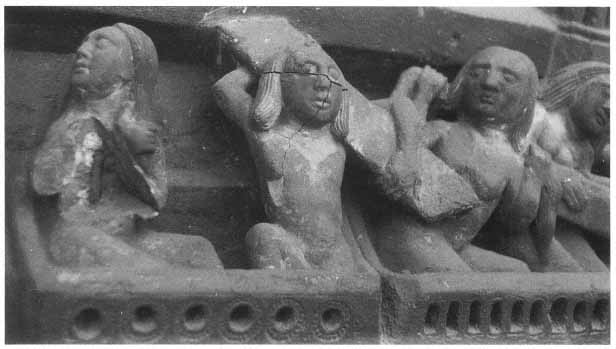
Fig. 11.
Frieze of the Resurrected Dead. Detail of lintel zone, right, nos. 18a-b and 19a-b
suggests the profile of a crown. The headdress also lacks the lateral peaks and the lappets that characterized twelfth-century miters, although the recutting and mastic overlay on the shoulder could have eliminated all traces of the lappets. The nineteenth-century hand, now lost, was raised, but not in the gesture of blessing appropriate to a bishop. Earlier photographs show the hand open, palm facing out, in a gesture of adulation or acclaim now impossible to verify. Neither the gesture nor the attribute held in the left hand resolves the identify of the figure. The shape of the attribute, a small round object capped with a worn and poorly articulated node, suggests either an orb or a pomegranate. The orb, a royal symbol, should be carried with the emblem upright, but here the small protuberance tilts forward. Therefore it is probably a pomegranate, an attribute equally appropriate for a resurrected king or bishop in expectation of immortality.[12]
Mutilated Figure
The loss of a portion of the nineteenth-century inset that replaced the head, arms, and chest of this figure (sarcophagus no. 18a, Fig. 11 and Plate IVb) demonstrates to perfection some of the techniques employed by the restorer. The triangular wedge that has fallen away reveals not only the surface of the old stone prepared to receive the inset, but also the upper portion of the pinning dowel still set into a hole that formed a pocket for the mortar (Fig. 11). The area,
a gaping inverted V, shows the surface of the twelfth-century stone smoothed and cut away on an inclined, stepped-back plane nearly to the level of the navel. The lost inset originally replaced the head, shoulders, upper torso, and all but the left elbow of the folded arms. Certainly too large in relation to the scale of the figure, the metal dowel, which had expanded and contracted with seasonal temperature changes, finally caused the loss of a portion of the restoration. Although the legs, hips, and lower abdomen consist of good unrecut twelfth-century carving, not enough survives to reconstruct the original pose. The remnant of the left elbow, which required a bent left arm, makes the arrangement plausible, if not certain.
Contorted Figure
The adjacent figure in the same sarcophagus (sarcophagus no. 18b, Fig. 11 and Plate IVb) reveals an earlier stage in the degenerative process, caused by the expansion and contraction of the pinning dowel. The splintering of the stone has already resulted in the loss of a wedge of old stone over the right rib cage (Fig. 11). A diagonal fracture runs from the upper right corner of the scar and continues through the joint of the nineteenth-century head at the base of the neck, across the chin, mouth, and into the left cheek, where it ends at the transverse fracture that bisects the restored head. Hairline cracks, portending the loss of another portion of the figure, define another rectangular section of old stone on the right side of the chest.
Because the figure provides one of the best-preserved examples of the lively twelfth-century figurate style and of the formal skill of the sculptor of the Resurrection frieze, its impending disintegration seems particularly unfortunate. The marvelously contorted but entirely plausible arrangement of the arms, the diagonal thrust of the lightly modeled torso, the bent right leg tensed to assist the upward impulse implicit in the right hand, not only reflect the physical effort necessary to raise the sarcophagus lid and emerge from the grave, but also reveal the artist's concern for anatomical reality, as well as his skill in rendering it.
Hair-Pulling Figure
In this figure (sarcophagus no. 19a, Fig. 11 and Plate IVb) another twelfth-century pose has survived, spared by both the iconoclasts and the restorer, who
replaced only the head and lightly recut the left hand (Fig. 11). The new head joins the body at the base of the throat; the lateral lines of joining conform to the contours of the head. The fists grabbing the locks of hair proved original—a lively conceit with a counterpart in gesture at the opposite end of the Resurrection frieze.
Coquettish Woman Adjusting Her Coiffure
Except for her head, left forearm, and hand, the figure of the woman (sarcophagus no. 11b, Plate IIIb) appears well preserved. Her acutely bent left elbow survives from the original carving and, as the factor determining the position of the new left forearm, authenticates her natural and feminine gesture. The pose suggests that at the moment of resurrection, the woman's first thought was for her appearance. Nearly freestanding, her delicately modeled body, naturally proportioned and anatomically correct, testifies to the artist's respect for the integrity of the human figure.
As a whole, differentiated not only by pose but also by sex, and even reflecting psychological differences, the figures of the frieze of the Resurrected Dead express the artist's concern for and awareness of traits that would distinguish individual types. The eye traveling across the lintel zone finds the coquette, the glutton, the demure, the pious, the vigorous, the lowly, and the mighty all represented and characterized in this animated row, awaiting judgment.
The artist responsible for the Resurrection frieze also carved other sections of the portal. We will gradually discover sculpture attributable to his hand in the lunette of the tympanum, in the figures on axis in the four archivolts, in the scenes of the Blessed and Damned on the innermost archivolt, and on the two jambs of the doorway. We have noted that in the Resurrection frieze he carved figures of natural but solid proportions that were anatomically correct, delicately modeled, and carefully differentiated. His treatment of draperies in the clothed figures and individualistic handling of drapery conventions set him apart from the two other masters whose work can be identified in the central portal. We will call this artist the Master of the Tympanum Angels, because those four figures represent his crowning achievement. The second master, styled the Master of the Apostles, carved the row of figures above the Resurrection
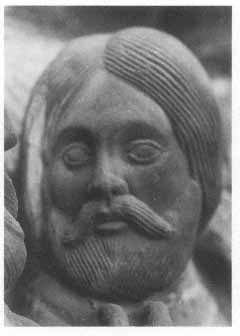
Fig. 12.
Nineteenth-century head, view from left.
Detail of Apostle no. 33, tympanum, far
right
frieze, but not the central figure of Christ. As we survey the sculptural ensemble and perceive the stylistic proclivities and preferences embodied in the work of each master, evidence will accumulate to attribute the figure of Christ to a third artist, the Master of the Elders (or patriarchs), who was responsible for those twenty-four figures in the three outer archivolts.
The Apostles, Virgin, and Flanking Angels
None of the figures of the Apostles in the middle zone of the tympanum (nos. 21–26, 28–33, Plates IIIb and IVb) escaped damage or the heavy hand of the restorer. Nevertheless, despite the fact that all heads belong to the nineteenth-century restoration, and a scattering of insets and recutting repair the random damage to the drapery, hands, and feet, much survives to reveal the richness and forceful character of those twelfth-century figures and the hand of the master who carved them. The restoration did not diminish their substantial, solid forms, nor did it alter their varied but restrained poses and gestures—all part of a well-ordered, rhythmic composition that avoided the tedium of a frieze of uniform figures.
Unfortunately the nineteenth-century heads have a shocking visual impact, even though some of the features and arrangements of hair and beard emulate characteristics of one of the mutilated twelfth-century heads from Saint-Denis now in the Louvre.[13] The similarities between the nineteenth-century head of Apostle no. 33 and the Louvre head (cat. no. 53) suggest that the
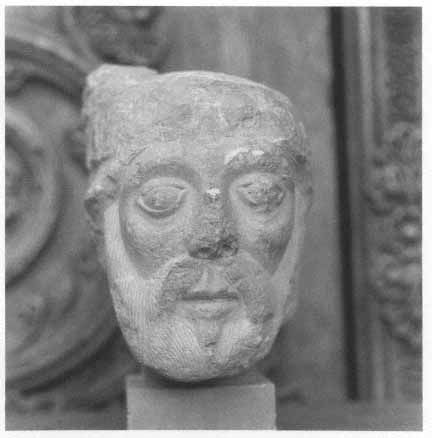
Fig. 13a.
Twelfth-century head from Saint-Denis. Paris, Musée du Louvre, cat. no. 53. The
head originally belonged to patriarch N, second archivolt, right
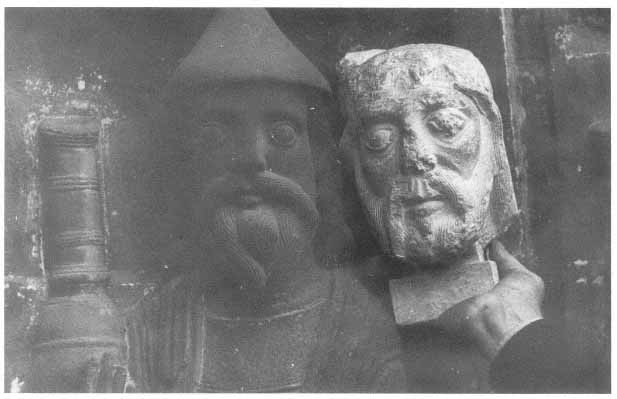
Fig. 13b.
Plaster cast of Louvre head (cat. no. 53) juxtaposed to the nineteenth-century
head in situ of patriarch N
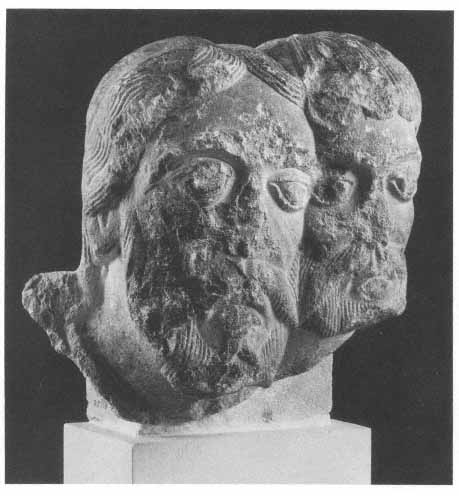
Fig. 14.
Twelfth-century heads from Saint-Denis originally belonging to Apostles nos. 21 and 22,
tympanum, left. Paris, Musée du Louvre, cat. no. 54
restorer had either that twelfth-century head or a similar one before him as a model (Fig. 12 and 13a). In the restored head, the hair convention, the arrangement of the beard, the broad forehead, spreading nose, wide philtrum, full lips, as well as the wide-set eyes and protruding eyeballs rimmed with wide bands representing the eyelids all seem an inept and bland parody of those same characteristics in the Louvre head.
Although the actual dimensions of the twelfth-century head proved congruent not with the Apostles' heads, but with the archivolt figures,[14] two smaller attached heads (Louvre cat. no. 54, Fig. 14) have dimensions compatible with the Apostles' measurements and consonant with the figures of Apostles nos. 21 and 22 on the far left (Plate IIIa). In addition to their correct proportions, the angle and length of the diagonal break or cut across the necks of the Louvre pair and the combined width of their heads (measured on a horizontal line drawn from the upper edge of the break across under the beards) correspond exactly to equivalent measurements taken along a horizontal line below the beards joining the modern heads of the two Apostles. The greatest
depth of the Louvre heads, measured along the break, falls within the tolerance of the greatest forward projection of the twelfth-century bodies along the diagonal line that joined the new heads.[15] In those telling measurements, which indicate a perfect match of the twelfth-century heads with the original bodies, we must note a single discrepancy. The restored heads face away from each other, whereas the Louvre heads are parallel and face frontally. Yet the latter agree perfectly with the frontal poses of the shoulders and torsos of the two Apostles, and the placement of the left head sightly forward of the right one also suits the relationship of the two bodies.
A portion of the original head of Apostle no. 33, on the far right, survives in situ (Plate IVb). That generous remnant provides an additional control in evaluating the proportions and positions of the nineteenth-century heads, as well as their projection from the background plane. The twelfth-century remnant to which the nineteenth-century restoration of the head of Apostle no. 33 is attached includes the hair framing the right side of his face. The line of joining coincides with the hairline along his cheek, but at the temple the joint enters the hair. Circling over the top of his head, the mortar joint moves forward to descend on the viewer's right, so that the twelfth-century fragment includes the entire back of the turned head and some of the hair at the back of the neck. The fully rounded form of the twelfth-century remnant does not stand free but nestles in the crook of the angel's wing stretching above and behind the Apostle. The fragment verifies the turn of the head, which also agrees with the alignment of the shoulders. Then, too, since the vestige includes the top of the head, it also preserved the head-to-body proportions of the seated figure, and, by extension, verifies the dimensions of the other heads as restored. With the exception noted in Apostles nos. 21 and 22, the rest of the Apostle heads all follow the dictates of the twelfth-century torsos and align either with the shoulders of the figure or, in the case of Apostle no. 32, with the focus of his attention. In that row of seated figures, the turn of the heads and bodies makes a significant contribution to the overall composition.
The formal organization of the Apostle frieze, with its planned movement and visual balance, emerges as an important characteristic of the sculptural ensemble—one that distinguishes it from its Romanesque predecessors. Depicted in apostolic dialogue, or in disputatione, those conversing Apostles carry on a tradition that goes back to Late Antiquity and signifies the essential
function of Christ's disciples as teachers of men. Medieval teaching took the form of disputatio, a discussion or debate about what is truth and what is falsehood.[16] The six Apostles on the left form two distinct groups of three figures. Within each group the figures relate to each other not only through their poses and gestures, but also in the arrangement of the folds of their draperies. Even the ornamental borders of their garments seem to band them together. The inside of the back hems functions similarly, enclosing three pairs of feet in each group, whereas the opposed swirls of the mantles and tunics of Apostles nos. 22 and 23 punctuate the grouping as emphatically as their figures turned in opposite directions (Plate IIIa). The arrangement of the Apostles on the right has even greater sophistication. The six break down into pairs that are either linked by gesture or represented in disputatione (Plate IVa). In counterpoint to the pairing, the artist has created two groups of three. That second division actually interrupts the conversation of the middle pair. Yet the identical unifying elements or devices used to link the trios on the left side of the tympanum create the grouping into threes on the right.
The authenticity of the gestures, as important to the iconography as to the composition, has been questioned in the past. Von Borries suggested that the Apostles originally held books and scrolls, their customary attributes, and that the Virgin (no. 27, Plate IIIb) should have been restored with one hand resting on her breast, the other holding a book. Dismissing her gesture as “groteske,” he interpreted the hand that holds the veil to her face not as the traditional gesture of mourning, but simply as the Virgin touching her veil to her nose.[17] In fact, the Virgin's elongated, softly rounded hands, her veil, and the crumpled, or goffered, inner sleeves delicately ornamented at the cuffs all consist of original unrecut stone (Fig. 15a). Touched only by age and weather, they provide unspoiled examples of the deft and sensitive twelfth-century carving, as does the elegant, ornamental border along the hem of her gown. The beading still visible along the seam on the toes of her pointed slippers adds a felicitous, realistic touch (Fig. 15b).
Guilhermy told an amusing anecdote with reference to the original restoration of the figure of the Virgin. Soon after the scaffolding was removed, an astute observer commented on the fact that there were thirteen Apostles at Saint-Denis, all of them with beards and mustaches. The “thirteenth Apostle” was, of course, the Virgin seated on Christ's right. At Didron's insistence,
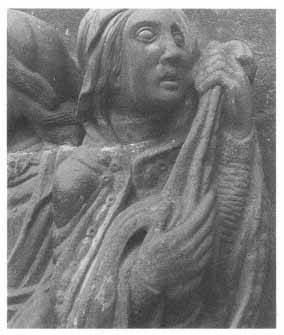
Fig. 15a.
Twelfth-century hands and nineteenth-century head of
Virgin, no. 27, seated at Christ's right, tympanum, left
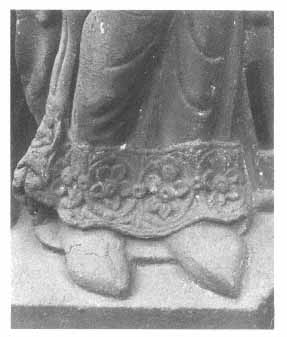
Fig. 15b.
Ornament along the hem of the tunic and the slippered
feet of Virgin, no. 27
Guilhermy wrote, “Quelques coups de ciseau lui ont donné, tant bien que mal, une expression plus féminine.”[18] “A few cuts of the chisel” somewhat underestimates the measures needed to rectify the initial error and achieve a “more feminine expression.” Two nineteenth-century joints, one directly under the Virgin's chin and another nearer the base of her neck, indicate that a second head was carved and most of the first one removed to make way for it (Fig. 15a).
The examination of the sculpture also authenticated the beautifully preserved hands of Apostles nos. 21 and 30 (Fig. 9 and Plate IIIa). Their fully undercut hands, like those of the Virgin, seem remarkable for their softly rounded forms, which contrast so blatantly with the clumsy nineteenth-century replacements. Note especially the restored hands of Apostles nos. 25 and 28 (Plates IIIb and IVb). The equally well-preserved right hand of Apostle no. 32 represents a different hand type (Plate IVb). Distinguished by the delicate articulation of the bone structure, this elongated and anatomically explicit hand proves more characteristic of the hands of the archivolt figures than of the Apostles (patriarchs A, G, Q, and R, Plates VI–VIII). This juxtaposition of distinct and unrelated styles emerges as one of the prevailing characteristics of the sculpture of the portal. The authentication of two or more distinct stylistic elements in the work of one artist at first surprises, but, in the final analysis, increases our understanding of the interaction of ideas in the exciting artistic environment which Suger's building campaigns encouraged.
The diagrams of the Apostle zone identify not only those surprisingly well-preserved hands, but also indicate all the minor repairs to the other hands
(Plates IIIb and IVb). Without exception, the restorations followed the requirements of the surviving portion of the forearms, wrists, and hands. Even the poorly executed inset replacing both hands of Apostle no. 25 has authentication in the twelfth-century cuffs still intact and visible behind the new hands. The stumps indicate that the original hands were freestanding, upraised, and close together. The prayerful attitude of the new hands therefore seems entirely probable. The upraised remnant of the forearm of Apostle no. 28, on Christ's left, also determined the placement of the new left hand, if not the curling fingertips. That position, the hand touching the chin, is one of many variants on the gesture of mourning. Since the Apostle is turning toward Christ and is not depicted in disputatione with his neighbor, the gesture seems quite appropriate and raises the question whether originally the figure on Christ's left was that of the beardless John. Many representations of the Deisis show John making the same gesture as restored here.[19] Possibly a Deisis was originally intended in conjunction with the Last Judgment instead of the Crucifixion, but evidence does not suffice to establish definitively that such a juxtaposition was an iconographical innovation originating at Saint-Denis.[20]
The hands of the angel with the flaming sword at the right end of the row of Apostles (no. 34, Plate IVb) follow the arrangement proposed by the original wrists and heel of the right hand. Assuming that both angels in the Apostle zone were those of the Second Coming sent forth “with a trumpet, and a great voice” to gather the elect (Matthew 24:31), von Borries dismissed the flaming sword as a nineteenth-century invention and proposed a trumpet as the original attribute.[21] Yet the unrecut surface of the angel's chest indicates that the original attribute was not held near his lips in a manner paralleling the trumpeting angel at the left end of the Apostle frieze (Plate IIIb). Then, too, the angel's movement toward the closed door below that represents the gate of Paradise clearly associates him with the gate and with the figure of the Foolish Virgin kneeling before the barred door—a relationship that gives credence to the sword as his attribute. Apparently the shut door referred to Matthew 25:10–12 and the parable of the ten virgins in which the symbolic door to Paradise was closed to exclude forever the five Foolish Virgins who symbolized the Damned. But the angel's attribute also refers to the cherubim with the flaming sword placed at the Gate to Paradise after the expulsion: “And he [the Lord] cast out Adam; and placed before the paradise of pleasure
Cherubims, and a flaming sword … to keep the way to the tree of life” (Genesis 3:24). The outsized bolt quite literally barring the door emphasizes New Testament imagery of the parable, just as the flaming sword attaches Old Testament imagery to the angel guarding the gate.
Although controversy also surrounds the restoration of the Apostles' feet, the diagrams indicate that all of the repairs, for the most part minor, followed the requirements of the twelfth-century sculpture. Von Borries questioned the arrangement of the inset replacing the right leg and foot of Apostle no. 23 (Plate IIIb).[22] Even though extremely inept and stylistically incongruous, the restoration perpetuated the original pose—the only possible arrangement that accords with existing circumstances. First and foremost, the area around the lower leg and foot appears unrecut. In addition, the crossed leg of the inset follows the dictates of the elevated right thigh and of the fragment of the original hand resting on the raised knee. Finally, the crowding of the feet of the first three Apostles allows no room on the footrest for another foot.
The arrangement of Apostles nos. 21 and 22 (Plate IIIa) represents an original and amusing solution to the problem of limited space. A similar overcrowding occurs on the far right, and in both instances the artist eschewed the Romanesque solution which, when space was limited, required only the correct count of heads. Striving for greater naturalism, the Saint-Denis artist took pains to represent the correct number of feet as well, and at least to suggest twelve bodies by actually seating Apostle no. 21 on the lap of no. 22, whose right foot pokes out from beneath the back hem of the Apostle on his lap. Even the small wedge of skirt drapery above his crowded left foot has a different ornamental border—another cryptic indication of his presence. The novel arrangement has a counterpart in the feet of Apostles nos. 25 and 26 (Plate IIIa); the latter has firmly planted his right foot on the instep of his neighbor.[23] Space was limited, and as the diagram shows, in both instances either the original feet or adequate remnants survive to verify the poses and the twelfth-century conceits.
In contrast to those inventive but naive arrangements, which nevertheless reflect the artist's attitude of respect for the integrity of the human form, the pose of Apostle no. 31 looks back toward the more stylized Romanesque manipulation of the human body (Plate IVa). Although notable for their delicate articulation, his feet are presented in a highly stylized, unnatural pose evoking
the Romanesque convention of crossed legs with feet confronted and sur les pointes. Yet like the feet of Apostle no. 33 (Fig. 16c), which also deserve mention for their elegant pose and beautiful modeling, the feet of no. 31 reflect the same careful observation of natural forms that characterizes the carving of the right hand of Apostle no. 32, the third member of the group.
The diagrams show at a glance that a great deal of extremely fine drapery has survived in those mid-tympanum figures. Untouched areas predominate and provide excellent examples of the way in which folds were manipulated to define the forms beneath. The figures in the frieze unite a sense of volume and substance with restrained gestures. Rich ornamentation and a subtle interplay of curves enliven every figure (especially no. 28, Figs. 16a-b and Plate IVa). The striving for accuracy in such details as the well-preserved border ornament contrasts with the more stylized but always vigorous draperies. The recutting never altered the basic arrangement of the Apostles' drapery, although in a few instances the restorer cut back the surfaces enough to blur or diminish the clarity of the folds (see recut areas as diagrammed: Apostles nos. 21, 23, 24, 28, 31, and 33, and angels nos. 20 and 34, Plates IIIb and IVb).[24]
Even in the heavily recut figures, much survives that preserves the work of the twelfth-century carver. In the figure of the trumpeting angel (no. 20, Plate IIIb), the flaring folds that sweep from hip to hem in a gravity-defying curve give authority to the angel who stands no higher than the seated figures. At the opposite end of the tympanum, the powerful impression created by the angel's figure accrues from its striking formal attributes (no. 34, Plate IV). The strong diagonals of the skirt drapery and hemline emphasize the thrust of weight from the right to the left leg. Together with the counter-diagonals of the left wing and sword, they underscore the angel's movement toward the barred Gate to Paradise and forcefully punctuate the right end of the frieze. The broadly conceived folds that encircle his right thigh—a convention subject to infinite variations, which occurs throughout the portal—in this figure firmly establish the anatomy of the leg beneath.
The artist demonstrated his skillful close observation of natural forms through a number of delightful devices, for instance the ripples of the borders of the garments as they break over the instep (Apostle no. 28, Fig. 16b). The arrangement subtly communicates not only the weight of the embroidered
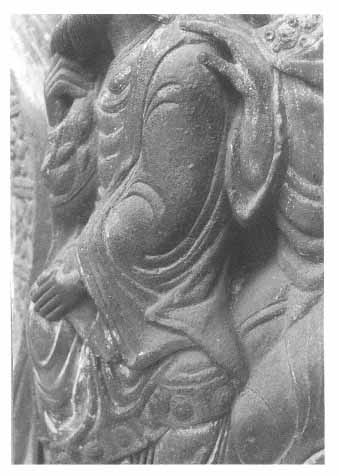
Fig. 16a.
Left sleeve of Apostle no. 28, tympanum, right
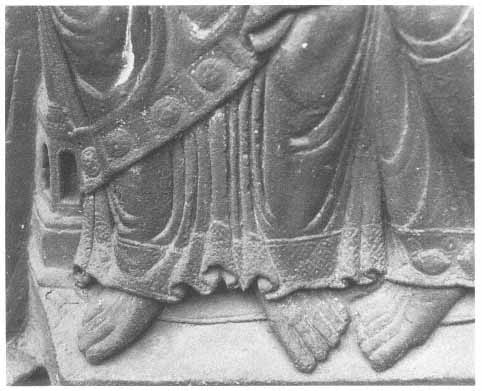
Fig. 16b.
Drapery over legs of Apostle no. 28
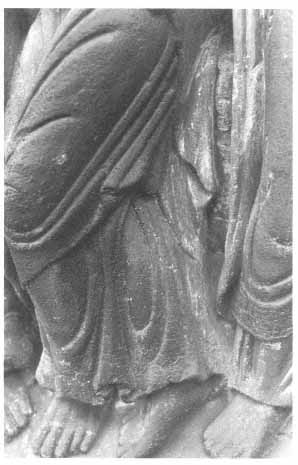
Fig. 16c.
Drapery over legs of Apostle no. 32, tympanum, right
and jewel-encrusted borders, but also the volume of the foot beneath (see also angel no. 20, Apostles nos. 21 and 25, and the Virgin, no. 27). The deeply modeled opulent folds and thick edges of the tunics and mantles, with their folded-back hems, give texture as well as weight to the fabrics (especially in the robes of angel no. 20, Apostles nos. 24 and 28, and the Virgin, no. 27). In all the figures, the artist manipulated stylized drapery conventions to reveal their solid forms. Stylized folds typical of the Languedoc—a convention distinguished by the narrow, articulated ridge that accents the crease of each fold—curve across the thighs (especially Apostles nos. 29, 30, and 33, Fig. 16c) or define the arm (Apostle no. 28, Fig. 16a). Folds with creases that cut into the flesh curve across the arms (angel no. 20 and Apostles nos. 23, 24, and 28). Concentric U -shaped folds clamp tightly around upper and lower legs (the Virgin, no. 27, and Apostles nos. 28, 29, 32, and 33), and encircling folds occasionally accent the bend of a knee (Apostles nos. 29, 30, and 33, Fig. 16c). The artist used those drapery conventions with restraint on the left side of the tympanum, but on the right he created richer, more turbulent patterns. Yet he also achieved a visual balance by endowing the figures on the left with a greater salience from the surface plane.
The Virgin (no. 27, Plate IIIa) and Apostle no. 28 (Plate IVa), at Christ's right and left, epitomize his contrasting treatment of the two groups. Presented in a three-quarter view so that her right shoulder overlaps that of her neighbor, the Virgin exists in three-dimensional space and has plausibility as a seated figure. Her person, gestures, and drapery consist of a series of overlapping forms enriched by the interplay of curves. The somewhat clumsy convention suggesting the effect of the seat of the bench on the heavy fabric of the skirt of her tunic adds to the impression of depth and projection by means of bold modeling and the flaring, undercut convolution of the hem. Encrusted with embroidery and jewels, the hem has a much less active line than that of Apostle no. 28 (Figs. 15b and 16b). The sense of projection of his broader, heavier figure seems somewhat diminished by the liveliness of the surface patterns of the drapery. Broadly conceived parallel folds curve across his chest, and folds accented with an incised line near the ridges define the contours of his left arm. Those highly stylized conventions contrast with the deep foldback of the mantle that responds realistically to the form of the left knee (Fig. 16a). The strongly modeled folds flanking his legs—a repetition of verticals located below the slashing diagonal of his richly ornamented mantle (Fig. 16b)—provide a needed variant on the constant circular motion of the folds on the upper body, of those that loop across his knees and shanks, and of the U -shaped drapery that defines his lap. The vigorous handling of each drapery convention gives strength and importance to a figure otherwise dwarfed by the overpowering central figure of Christ. On the other side of the throne, the authority given to the figure of the Virgin by means of her pose, the interplay of broadly conceived curves, the heavy fabrics of her garments, and the solidity of her projecting form provides the requisite visual balance to Apostle no. 28.
The entire frieze of seated figures, forcefully presented but balanced and beautifully organized, reveals the Apostle Master's highly developed formal sophistication, his interest in natural forms and in textures, and his delight in varied and sumptuous detail. Although he used Romanesque drapery conventions, he also manipulated them to emphasize the solid volumes beneath. The interesting and varied figures, in which the artist juxtaposed stylizations with naturalistic effects, embody the tensions of opposing ideas. As a result, such details as the handling of a sleeve, the drapery of a mantle, or the folds
defining a leg (Figs. 15a and 16a–c) often give greater pleasure than the figure as a whole. This fascinating and surprisingly well-preserved portion of the sculpture of the central portal deserved a better fate than marriage with the visually devitalizing nineteenth-century heads.
The Lunette with Tympanum Angels
As a group, the four angels of the upper tympanum zone (nos. II–V, Plate IIc–d) suffered less in the hands of the restorer than the sculpture of the lower zones. These fluent and harmonious figures that retain so much of the twelfth-century aesthetic seem particularly incompatible with the monotonous facial style of the nineteenth-century heads. As the diagramming shows, the insets replacing three of the heads join the twelfth-century torsos approximately along the collar lines (angels nos. II–IV). The repair of the head of angel no. V on the far right, the best preserved of the four, involved an inset replacing only the face. Most of the original head survives as an excellent example of a highly stylized twelfth-century coiffure with finely drawn, striated hair. This coiffure probably provided the model for the restored locks of the companion figure at the far left (angel no. II). But in emulating the arrangement, the nineteenth-century sculptor produced harsh caricatures of the delicately carved, separated locks which frame the forehead of angel no. V.
Two of the restored heads seem to compromise the twelfth-century design in still another respect. The positions of the new heads of the two angels flanking the cross (angels nos. III and IV) fail to comply with surviving vestiges of the original hair spreading across their shoulders. Raised too high, the heads interrupt the continuous line proposed by the twelfth-century remnants.
The same two central angels carry objects of Christ's Passion—all nineteenth-century insets—and no fragments of the original objects have survived to authenticate the restorations. Yet the position of the angels' hands indicates that originally three attributes existed, two held by no. III and one by no. IV. Hovering on Christ's left, angle no. IV holds the least controversial attribute, the Crown of Thorns. His twelfth-century arms frame a space quite appropriate for such a circular object, yet unquestionably the twelfth-century crown would have been less coarse and prominent.
Separated, cupped hands covered by a single veil indicate that angel no. III originally presented two objects. Most of the nineteenth-century restoration in his right hand has fallen away; only the stone stumps of two square nineteenth-century nails remain to the left of a round brass dowel that projects from the center of the broken inset. At the right of the brass dowel, visible from above and flush with the cupped hand, the square-cornered outline of the joint of the inset indicates the dimensions of a lost portion of the nineteenth-century replacement. The original size and shape of the repair provide strong evidence that the restoration, if not the original representation, included four nails carved of stone.[25] The fragments certify that the restorer intended to represent the four that attached Christ to the cross, but the dowel of brass presents a puzzle for two reasons. At 0.75 cm. in diameter, it is much larger than all nineteenth-century pinning dowels now visible. In addition, those dowels are made of iron. This anomalous brass dowel raises an unanswerable question: was the original attribute in this angel's right hand a single nail—a reference to the one nail listed at Saint-Denis among the treasured relics of the Passion, along with thorns from the Crown of Thorns?[26]
The other attribute, a freestanding block of nineteenth-century stone in the angel's left hand, presents an even greater puzzle. It has an irregular, roughened upper surface with incisions or striations on both of the faces visible from below. Apparently intended to represent a broken piece of wood symbolizing a portion of the True Cross, the attribute seems questionable because of its redundancy, inasmuch as the two outer angels, nos. II and V, are supporting the arms of the cross that backs the central figure of Christ.[27] Unfortunately, no fragments of the original attribute have survived to provide clues justifying any other proposal concerning the nature or iconography of the twelfth-century object.[28]
On the left side of the tympanum, both wings of angel no. II and the right wing of no. III date from the restoration. The sharp contours and the lack of delicacy in the surface articulation seem at complete stylistic variance with the twelfth-century wings. Close examination indicated that in their placement, the restorations perpetuated the original arrangement. On the far left and directly to the left of the fissure in the upper tympanum stone, the twelfth-century tip of the right wing of angel no. II survives against the foliate molding. That small fragment authenticates both the size and the position of the replacement. Behind the left wing, the surface plane shows extensive gouging and roughness
caused by the removal of the original wing. As well as verifying the placement of the modern wing, the gouging also revealed a metal dowel inserted from the inside to clamp one of the interior reinforcing slabs attached to the tympanum.[29] Bolts secure the new wings to the upper tympanum stone, and mortar hides the screw heads in the surface of the wings.
On the opposite side of the tympanum, both wings of angel no. V survive from the twelfth century. Covered with finely drawn overlapping feathers, their surfaces completely escaped recutting. Yet the fracture that crosses the angel's right wing apparently threatened its survival. To the right of the fracture the restorer therefore sliced off and removed the front face of the entire shoulder of the wing, then shaved back the remnant to the level of the background plane and reset the shoulder in white cement built up from the surface plane. In so doing, he closed the gap caused by the tympanum fracture so that the reset section of the wing now interrupts its course. Similar cement backing also reinforces the same angel's left wing as well as the original left wing of angel no. III. Although each of the other three extant twelfth-century wings in the upper tympanum group has a nineteenth-century patch (see angels nos. III and IV), the deft and delicate modeling of the original surface feathers shows no recutting.
The placement of all those beautiful wings deserves particular attention, since it reflects new ideas that distinguish the sculpture at Saint-Denis from that of earlier portals. The artist of the lunette did not fully accept the restrictions of the frame. The wings of all four angels violate its confines; they spread across the foliate molding that encloses the tympanum (as do those of the two angels at either end of the Apostle frieze). Nor did the artist allow the crowding typical of many Romanesque Last Judgment scenes, with the attendant distortions caused by confining human and animal forms within the strictures of an allotted space or of an ornamental design. Although the horizontal poses of the angels as well as their placement accommodate to the shallow curve of the lunette-shaped stone, the sculptor nonetheless created figures with credible proportions. He adapted them to the spatial limitations by overlapping the figures—a treatment that gives them additional reality in terms of three-dimensional space. The same balance, order, and clearly defined spatial relationships that characterize the lower zones also prevail in the upper lunette.
The restorer may have thought to improve on the twelfth-century sculptor's illusion of space by cutting back the surface plane above the figures of the
angels. That change, an alteration rather than a repair, increased the visual impression of the forward projection of the figures. The recutting begins at the left between the wings of angel no. II, where it also flattens the torus. Continuing to the right, recutting increasingly affects the surface plane above the figure of angel no. III. The areas to the left and right of the stem of the cross, however, appear unrecut and provide a control establishing both the original surface level of the background and also the profile of the roll molding. The severe recutting resumes between the wings of the angel to the right of the cross (angel no. IV), where it reduces the width of the foliate band as much as 4 cm. and again flattens the torus. The drastic cutting-back continues into and terminates in the area between the wings of the angel on the far right. Although light recutting occurs along the upper surface of that angel's body and over both feet, the adjacent surface plane and the foliate molding show absolutely none. Higher up, the cutting-back of the surface plane extended behind the wings, which magnifies the viewer's sense both of depth and of forward projection. On the right, where the shaving-back and distortion are greatest, recutting actually altered the curve of the arc of the lunette, but the wings and surrounding foliage survive in excellent condition—evidence that the change in the level of the surface plane could not have represented a needed repair.
The recutting becomes explicable only as an effort to impose the restorer's aesthetic preference on the twelfth-century artist's work. The initials MB in Roman lettering were cut into the surface plane to the left of the cross. An identical monogram recurs on the cut-back surface above the southeastern capital of the hemicycle of the crypt. Perhaps proud of his contribution, the restorer who tampered with the surface plane did not wish to remain entirely anonymous.[30]
Damage to the sculpture, not an aesthetic preference, dictated the recutting of the background to the right of the veiled hands of angel no. III and to the left of no. IV. The recutting eliminated portions of the veil fluttering from the angels' hands across the surface plane. The loop of the scarf that encircles the right arm of the latter angel shows the loss of at least one outer fold. For the most part, however, the recutting of the drapery of all four angels proved surprisingly light, so light that it modified but did not eliminate all traces of surface damage. The heaviest recutting occurred on the left hand and along the scarf covering the left wrist of angel no. II, on the right and left shoulders respectively of angels nos. III and IV, and on the left hand of the angel of the far
right. Yet those skinned areas still have surface scars and abrasions, and even the teardrop folds, a significant stylistic hallmark of the Master of the Tympanum Angels, survived the light recutting.
As well as the teardrop fold, the four angels share a number of conventions that distinguish the Angel Master's hand. In forming that stylized teardrop, he characteristically added two short, parallel curving lines on the ridge just beyond the depression. They enclose the cavity in the same way that quotation marks set off spoken words in a sentence. When occurring in the scarves and sashes, those deep, narrow creases that terminate in a teardrop seem designed to enliven and vary the lines of parallel folds as the drapery curves around the upper bodies and loops over the arms. The fluid, linear patterns created by the multifolds of the scarves help to define anatomies and elaborate gesture. The draperies of the scarves reveal the artist's fascination and obvious delight in the interplay of curves. The various conventions that define the legs and thighs show the same preoccupation with curving lines repeated in a series. Overlapping folds encircle the smooth-ridged thighs and knees. (See especially angels nos. II and V.) The sculptor frequently enriched the clapboardlike drapery framing the legs with ridges that accent the edge of each fold in a manner considered typical of Romanesque sculpture in the Languedoc. Tubular hook folds, defined by creases that cut into the flesh of the leg, curve around the thighs and shins and advance the sense of volume and form beneath the drapery. One of the tubular folds in the perfectly preserved leg drapery of angel no. V pinpoints the knee by completely encircling it (compare also the left elbow of angel no. IV), and the cascade of drapery falling from the left hip flows into an unusual sickle-shaped hook that loops around the bend of the knee. Those encircling folds accenting the joints come from the vast storehouse of Romanesque drapery conventions from which this artist drew freely. Always partial to the curving line, the sculptor preferred the U -shaped to the V -shaped fold; although occasionally the lowest fold in one of the concentric series sharpens and approaches an angled V, as, for instance, in the drapery below the right hand of angel no. V.
This versatile master also preferred active silhouettes for the hemlines of the garments, scarves, veils, and sashes. But instead of splaying or spreading apart, the inner edges of his symmetrical underfolds meet in the center. That preference contrasts with the splayed inner edges of the foldbacks along the hem of the seated Christ of the tympanum, as well as the typical handling of that
detail in the drapery of the patriarchs (see figures N and O, Plate VIIIa). The best examples of the Angel Master's treatment occur in the series of overlapping pleats in the veils covering the hands of angels nos. III and IV, and in the trailing scarves of angels II and V. Those convoluted edges, thick, but softly rounded, also typify the texture and weight that the master gave to fabrics.
The varied gestures of the angels animate the essentially symmetrical arrangement of the carefully composed group. The lower legs and feet of the central angels lie behind the heads and shoulders of the outer two. Thus, by overlapping the figures the artist was able to preserve their normal proportions and create significant empty, undecorated spaces on either side of Christ's head. The deliberate use of voids focused attention on the central theme. Such didactic clarity signals a concept of design quite unlike the familiar overall patterns of Romanesque compositions, which give the impression of a horror vacui.
Marked by their unity in style and composition, the four tympanum angels have strong stylistic affinities with the best preserved figures in the inner archivolt and with the jamb figures of the Wise and Foolish Virgins. The scenes of the first, or inner archivolt depict the fulfillment of Christ's judgments as related in the gospel of Matthew.